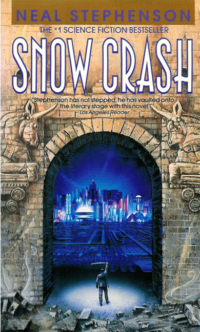Braiding the parallel rays into a dappled pattern
 Snow Crash
Snow Crash
by Neal Stephenson
Since its publication in 1992, this book has come to be considered a modern classic. I remember Tim reading it around 12 years ago and loving it – indeed, he still remembers it in remarkable detail. So in my ongoing science-fiction education, this seemed like a natural step.
This book has a fascinating setting that, though complex enough to be slowly revealed over 470 pages, is at heart simple enough to not require masses of exposition at the start. Instead, Stephenson opens with an action-packed sequence that introduces our main character – the aptly named Hiro Protagonist – and his foil, YT.
Hiro is a freelance hacker. His home is a storage unit that he shares with an up-and-coming rock star, a cramped situation that suits him fine because he spends most of his time in the Metaverse anyway – an alternative space that anyone with virtual-reality goggles and what is effectively an Internet connection by another name can plug into. In the Metaverse, your avatar can own property, socialise and explore in the vast space created many years ago by Da5id – superstar hacker and old friend of Hiro’s. In the Metaverse, Hiro is a sword-fighting expert, but in Reality (always written with a capital R) he delivers pizza to pay the bills.
“Hiro Protagonist and Vitaly Chernobyl, roommates, are chilling out in their home, a spacious 20-by-30 in a U-Stor-It in Inglewood, California. The room has a concrete slab floor, corrugated steel walls separating it from the neighbouring units, and – this is a mark of distinction and luxury – a roll-up steel door that faces north-west, giving them a few red rays at times like this, when the sun is setting over LAX. From time to time, a 777 or Sukhoi/Kawasaki Hypersonic Transport will taxi in front of the sun and block the sunset with its rudder, or just mangle the red light with its jet exhaust, braiding the parallel rays into a dappled pattern on the wall.”
He meets YT when a pizza delivery goes horribly wrong, attracting the wrong kind of attention to them both. She is a 15-year-old Kourier, riding a skateboard, hitching rides attached to the fastest cars to achieve the best delivery times. She’s an adrenaline junky and as such is much more comfortable than Hiro with the way their accidental meeting leads them both into a dangerous adventure in both Reality and the Metaverse.
The background to all of this is a near-future/alternative present in which megacorporations reign supreme. Such large chunks of America (and, indeed, the world) have been privatised and installed their own laws, security and even citizenship, that the US government is at best a joke.
“Like all Sacrifice Zones, this one has a fence around with yellow metal signs wires to it every few yards:
‘WARNING: The National Parks Service has declared this area to be a National Sacrifice Zone. The Sacrifice Zone Program was developed to manage parcels of land whose clean-up cost exceeds their total future economic value.’
And like all Sacrifice Zone fences, this one has holes in it and is partially torn down in places. Young men blasted out of their minds on natural and artificial male hormones must have some place to do their idiotic coming-of-age rituals. They come in from Burbclaves all over the area in their four-wheel-drive trucks and tear across the open ground, slicing long curling gashes into the clay cap that was placed on the really bad parts to prevent windblown asbestos from blizzarding down over Disneyland.”
Inbetween the high-tech setting and the action-packed story, there’s a philosophical strand to the book, exploring the idea that religion, drugs and viruses are sides of the same coin. This concept is rooted in a long and detailed history of Ancient Sumeria, with some sidetracks into etymology, which was all initially fascinating, but went on far too long for my taste. I’m sympathetic to the idea of religion as a tool to take advantage of the vulnerable, but I did get fed up of the infodumps.
There are many wonderful details in the Snow Crash world. A super-raft of refugees is being collected by an eccentric billionaire and brought to America, but possibly not for altruistic reasons. There are genetically engineered, or maybe cyborg, guard creatures that look like giant rats but think like dogs, and Stephenson writes a few chapters from their perspective. It sounds ridiculous but completely worked for me. Generally, the book treads a fine line between the profound and the daft. While it doesn’t get completely into the minds of Hiro and YT, they are interesting, sometimes unpredictable characters whose company I enjoyed.
First published 1992 by Bantam.
Source: Borrowed from Tim.